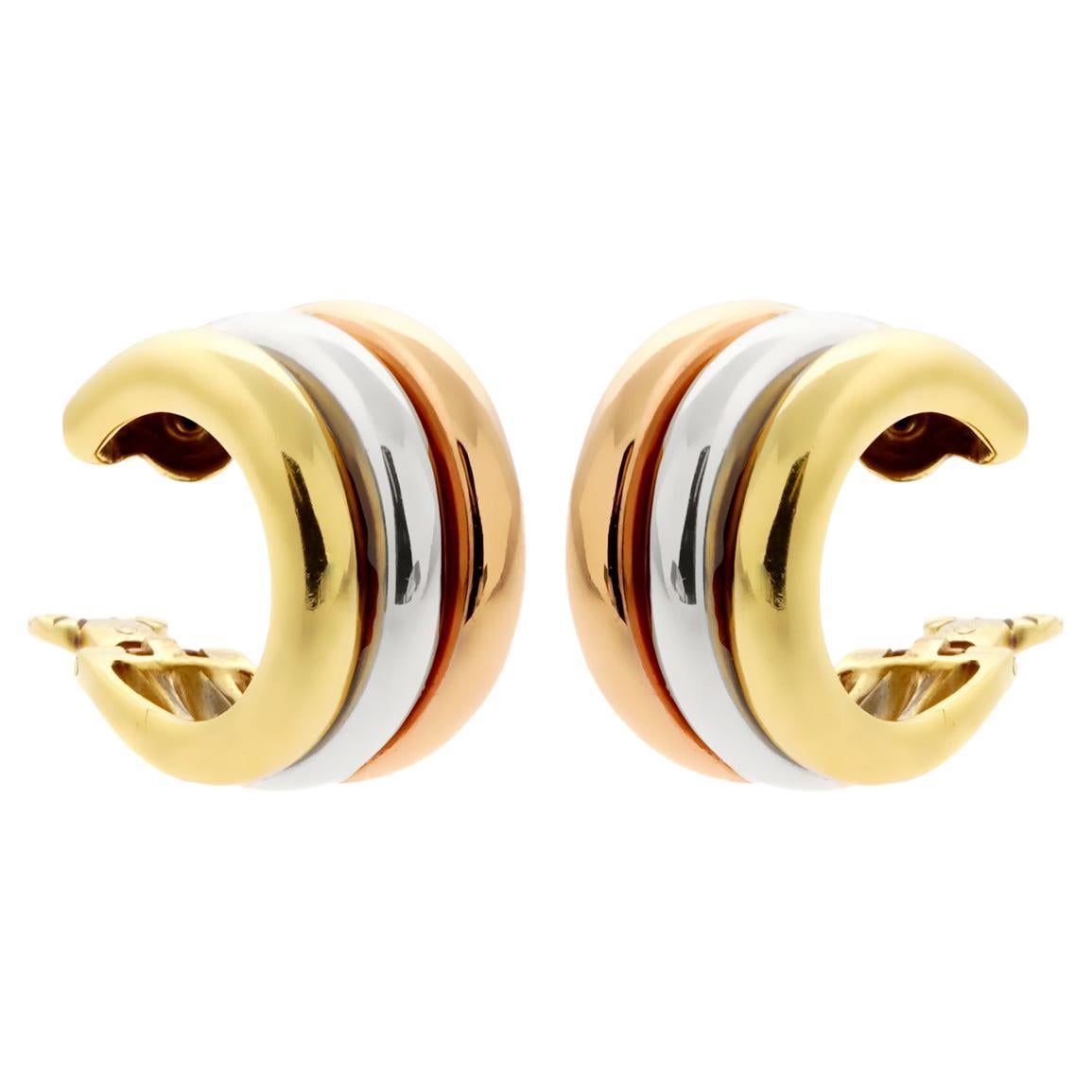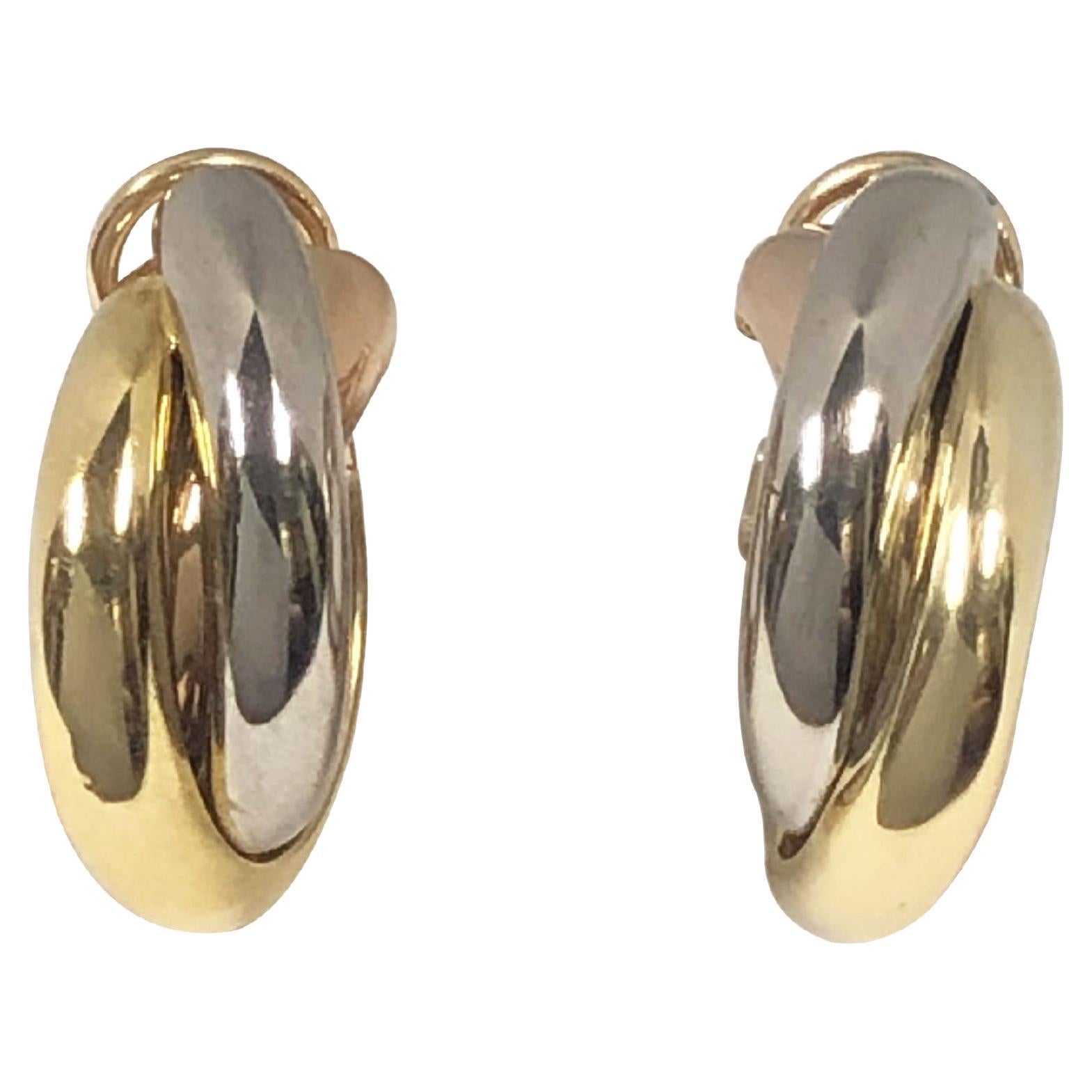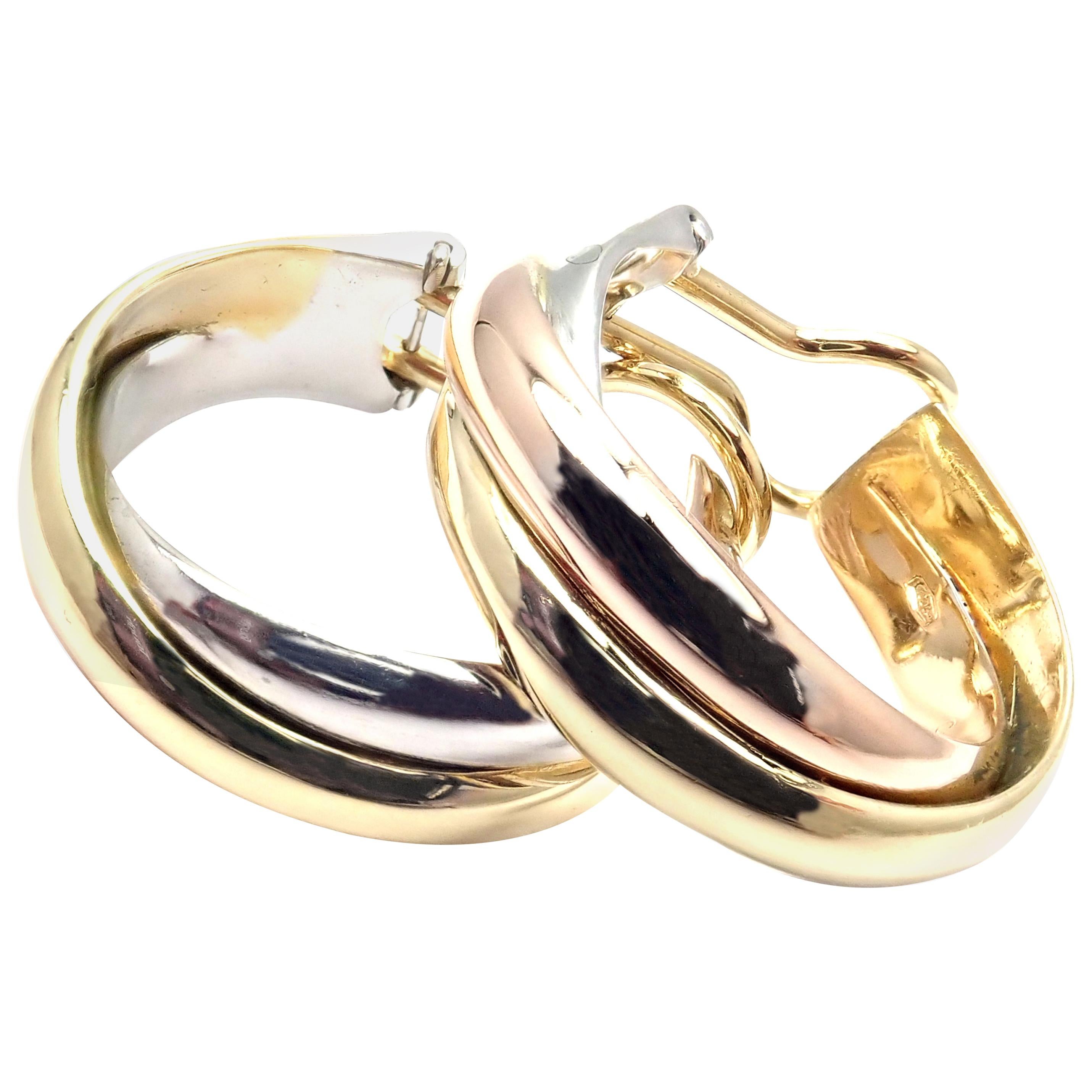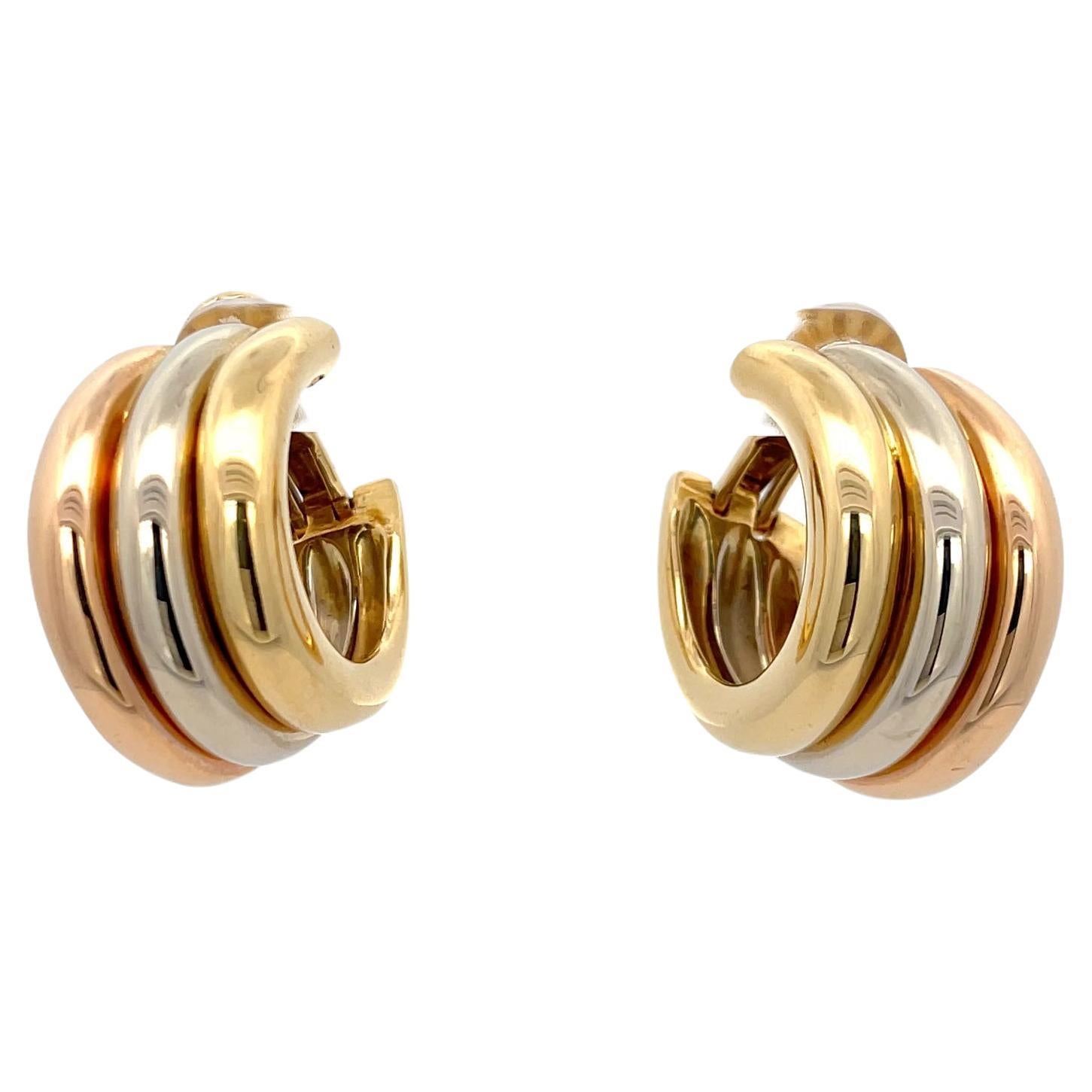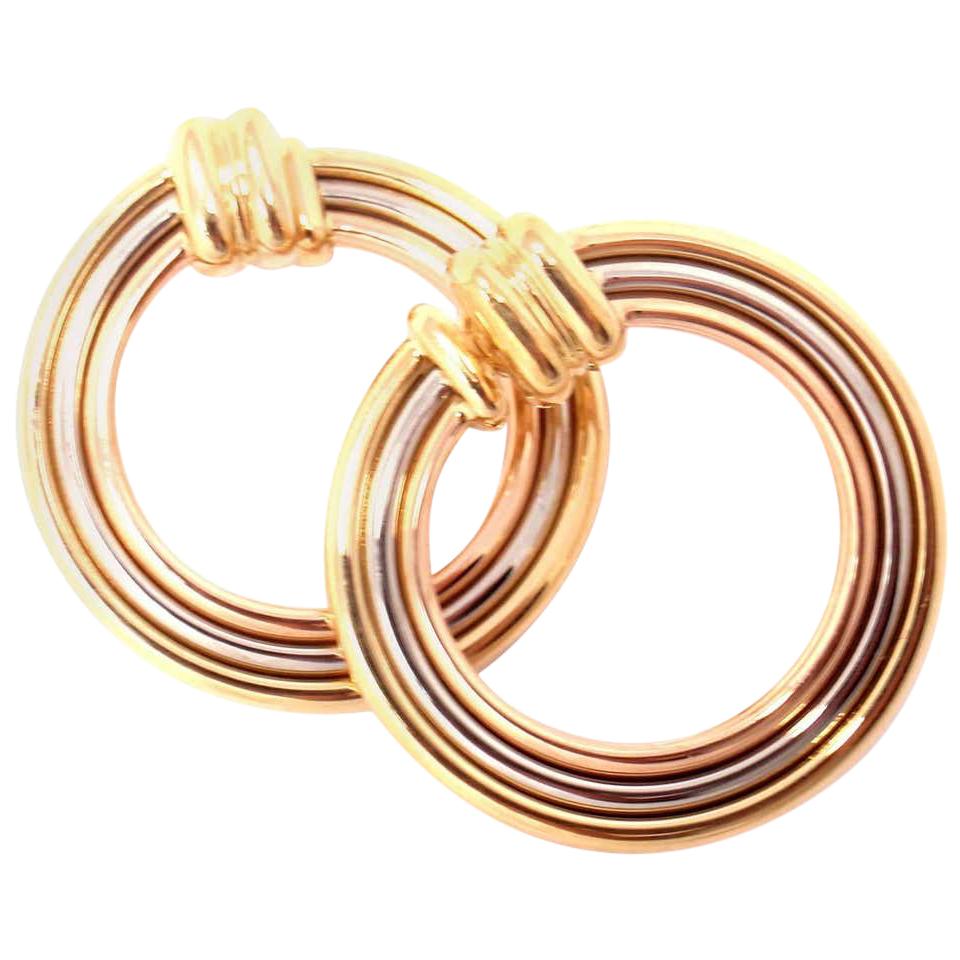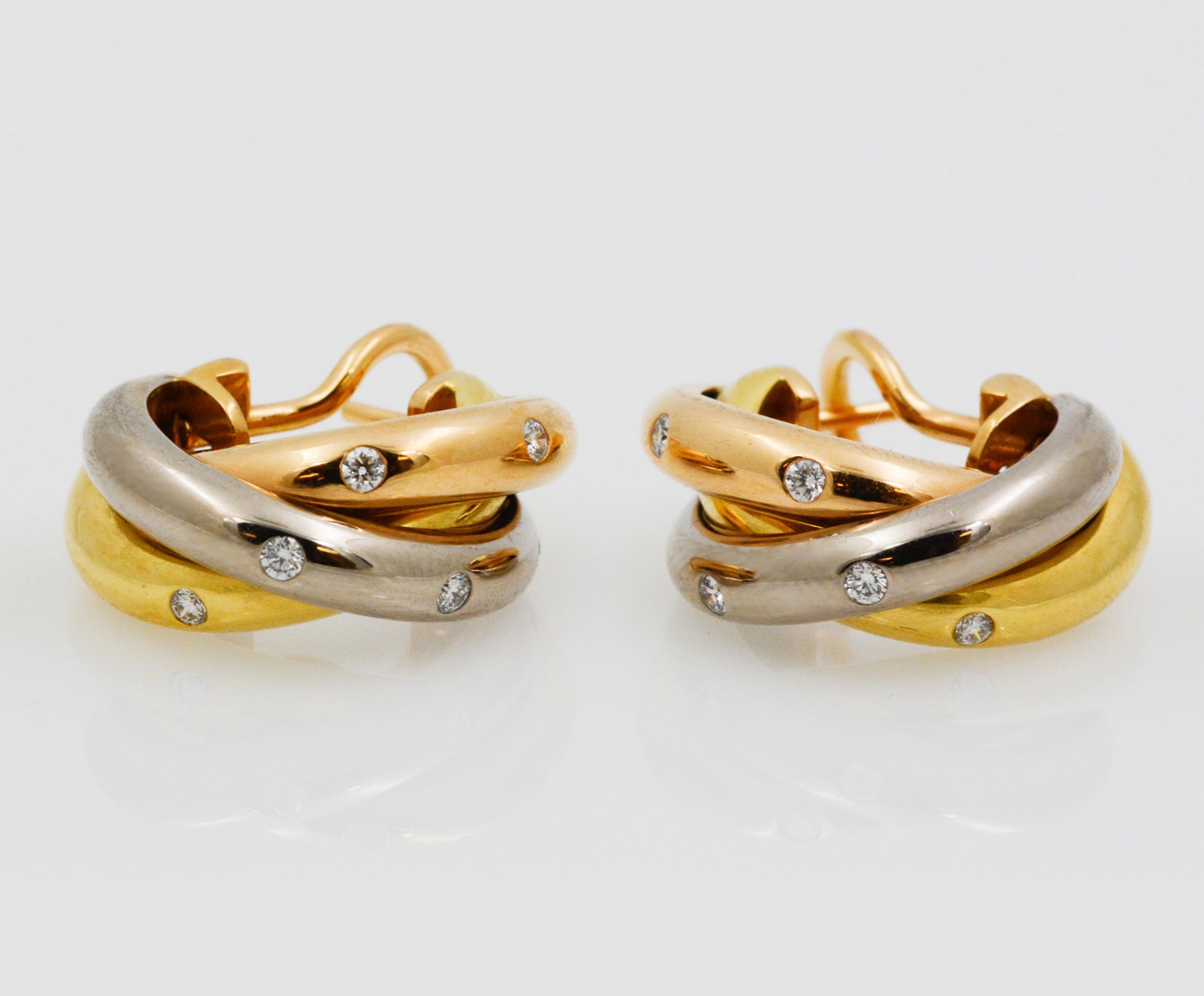Cartier Large Trinity Hoop Tri-Color Gold Earrings
About the Item
- Creator:
- Design:
- Metal:
- Weight:15.4 g
- Place of Origin:
- Period:
- Date of Manufacture:1999
- Condition:
- Seller Location:Holland, PA
- Reference Number:
Trinity Earrings
The Art Deco movement was in full swing and the seductively opulent flapper style was at its peak when Cartier introduced its Trinity collection, a line of minimalist jewelry that now includes Trinity earrings. Although the line broke with the decorative trends in jewelry at the time — the era’s designers looked to African art, crafted geometrically rich diamond brooches and opted to set rings with colorful stones such as coral and turquoise — the Trinity earrings and other pieces in the collection are an example of French elegance, interlacing naturalism and classicism in a simple and timeless way.
Designed in 1924 by Louis Cartier (1875–1942), the grandson of the heritage jewelry house’s founder, the Trinity earrings share the same simple aesthetic as the tricolored Trinity ring. Like the ring's bands, the earrings consist of three connected hoops, each a different type of gold to represent the three phases of a relationship: the white stands for friendship, the pink for love and the yellow for fidelity. The Trinity collection may have debuted with the ring, its three bands forever joined in embrace, but in the decades since its original design, the ring has given way to a broader beloved series of Trinity jewels, including the Trinity necklace, Trinity wedding band, Trinity earrings and more.
While the original Trinity earrings are still in production and the most popular, variations on the motif have yielded a bold reshaping of the hoops, so much so that they’ve ended in a knot on occasion. The jewelry house has also introduced versions that outfit the three hoops with diamonds or colored gemstones. Some iterations are adorned with so many pavé diamonds that the metal beneath is barely visible.
While the Trinity knot itself has appeared in Irish jewelry and has roots in other cultures, Louis Cartier reportedly crafted the now classic and instantly recognizable Trinity ring at the request of his friend Jean Cocteau. The French poet, novelist and Surrealist filmmaker dreamed of Saturn’s rings in his slumber — some several hundred years after they were first observed by Galileo through his telescope — and hoped to see the otherworldly visions brought to life as jewelry. Cocteau was understandably impressed with the modern and richly symbolic accessory that followed.
Trinity earrings have been a staple of Cartier’s collection since they were added to the original, and marquee admirers such as Princess Diana and Gary Cooper contributed to the line’s fame. But thanks to Cocteau’s dream, the design has always had “star power” in the most literal sense.
Cartier
For its extraordinary range of bracelets, watches, rings and other adornments, French luxury house Cartier is undeniably one of the most well known and internationally revered jewelers in the world among clients both existing and aspirational.
Perhaps 1847 was not the ideal time to open a new watchmaking and jewelry business, as the French Revolution was not kind to the aristocracy who could afford such luxuries. Nevertheless, it was the year Louis-François Cartier (1819–1904) — who was born into poverty — founded his eponymous empire, assuming control of the workshop of watchmaker Adolphe Picard, under whom he had previously been employed as an assistant. Of course, in the beginning, it was a relatively modest affair, but by the late 1850s, Cartier had its first royal client, Princess Mathilde Bonaparte, niece of Napoleon Bonaparte, who commissioned the jeweler to design brooches, earrings and other accessories.
Under the leadership of Louis-François’s son, Alfred, who took over in 1874, business boomed. Royalty around the world wore Cartier pieces, including Tsar Nicholas II of Russia, the Maharaja of Patiala and King Edward VII, who had 27 tiaras made by the jewelry house for his coronation in 1902 and issued Cartier a royal warrant in 1904. (Today, the British royal family still dons Cartier pieces; Kate Middleton, Duchess of Cambridge, regularly sports a Ballon Bleu de Cartier watch.)
Cartier’s golden years, however, began when Alfred introduced his three sons, Louis, Pierre and Jacques, to the business. The brothers expanded Cartier globally: Louis reigned in Paris, Pierre in New York and Jacques in London, ensuring their brand’s consistency at their branches across the world. The trio also brought in such talents as Charles Jacqueau and Jeanne Toussaint.
One of Cartier’s earliest major successes was the Santos de Cartier watch — one of the world's first modern wristwatches for men. (Previously, a large number of people were using only pocket watches.) Louis designed the timepiece in 1904 for his friend, popular Brazilian aviator Alberto Santos-Dumont, who wanted to be able to check the time more easily while flying.
Cartier’s other famous timepieces include the Tank watch, which was inspired by the linear form of military tanks during World War I, and the so-called mystery clocks. Invented by watchmaker and magician Jean-Eugène Robert-Houdin and later crafted exclusively for Cartier in the house’s workshop by watchmaker Maurice Couët, the mystery clocks were so named because the integration of glass dials on which the clocks’ hands would seemingly float as well as structures that are hidden away within the base give the illusion that they operate without machinery.
On the jewelry side of the business, Cartier’s internationally renowned offerings include the Tutti Frutti collection, which featured colorful carved gemstones inspired by Jacques’s trip to India and grew in popularity during the Art Deco years; the panthère motif, which has been incorporated into everything from brooches to rings; and the Love bracelet, a minimal, modernist locking bangle inspired by medieval chastity belts that transformed fine jewelry.
While the Cartier family sold the business following the death of Pierre in 1964, the brand continues to innovate today, renewing old hits and creating new masterpieces.
On 1stDibs, find a growing collection of contemporary and vintage Cartier watches, engagement rings, necklaces and other accessories.
- ShippingRetrieving quote...Ships From: Holland, PA
- Return PolicyA return for this item may be initiated within 1 day of delivery.
- Cartier Large Size Trinity Swirl Hoop Tri-Color Gold EarringsBy CartierLocated in Holland, PA18k Tri-Color (Yellow, White, Rose) Gold Large Size Trinity Hoop Earrings by Cartier. These earrings are for non pierced ears but they can be converted by adding posts. Details: ...Category
1990s French Hoop Earrings
MaterialsGold
- Cartier Medium Size Trinity Hoop Tri-Color Gold EarringsBy CartierLocated in Holland, PA18k Tri-Color (Yellow, White, Rose) Gold Medium Size Trinity Hoop Earrings by Cartier. These earrings are for non pierced ears, but they can be converted by adding posts. Details: ...Category
20th Century French Hoop Earrings
MaterialsGold
- Cartier Magnolia Tri-Color Gold Hoop EarringsBy CartierLocated in Holland, PA18k Tri-Colored Gold (Yellow, White, Rose) Cartier Magnolia Earrings by Cartier. These earrings are for pierced ears. Details: Weight: 15.3 grams ...Category
20th Century French Hoop Earrings
MaterialsGold
- Cartier Signature C De Cartier Large Yellow Gold Hoop EarringsBy CartierLocated in Holland, PA18k Yellow Gold Signature C De Cartier Large Hoop Earrings by Cartier. These earrings are in mint condition and they are made for non-pier...Category
1990s French Hoop Earrings
MaterialsYellow Gold
- Cartier Trinity Tri-Color Gold Wide Band RingBy CartierLocated in Holland, PA18k White, Yellow And Rose Gold Trinity Wide Band Ring by Cartier. Details: Ring Size: European 51 US 5 3/4 Width: 10mm Weight: 6.7 grams Stamped Hallmarks: Cartier 750 51-76XXXX(s...Category
1990s French Band Rings
MaterialsGold
- Cartier Inside Out Diamond Large Hoop Yellow Gold EarringsBy CartierLocated in Holland, PA18k Yellow Gold Diamond Large hoop earrings by Cartier. With 90 round brilliant cut diamonds total weight approximately 2.94ct. Diamonds VS1 clarity, E color These earrings come wi...Category
2010s French Hoop Earrings
MaterialsDiamond, Yellow Gold
- Cartier Trinity Large Tri Color 18k Gold Hoop EarringsBy CartierLocated in Feasterville, PAA fabulous and elegant pair of authentic Cartier hoop earrings featuring 18k white, yellow and rose Cartier gold in a timeless and modern design. They curve gently around the base of...Category
1990s Clip-on Earrings
Materials18k Gold
- Cartier Trinity Tri Color 3 Row Gold Hoop EarringsBy CartierLocated in Chicago, ILCirca 2000 Cartier Trinity collection 18K Yellow, Rose and White Gold Hoop Earrings, measuring 7/8 inch in length 7/8 inch in diameter and 3/8 inch wide. having Omega backs to which ...Category
Early 2000s French Hoop Earrings
Materials18k Gold
- Cartier Trinity Tri-Gold Hoops 18KBy CartierLocated in Dallas, TXEstate Cartier Trinity Tri-Gold Hoops in 18K Gold. The earrings measure approximately 1 inch by 1/2 inch and weigh 35.5 grams. Stamped Cartier 1994.Category
1990s Hoop Earrings
MaterialsGold, 18k Gold, Rose Gold, White Gold, Yellow Gold
- Cartier Trinity Hoop Earrings - LargeBy CartierLocated in New York, NY18-karat Tri-color Gold - Rose, Yellow, and White Total Weight: 16.2 grams Measurement: 2 1/8 inches x 2 1/8 inchesCategory
21st Century and Contemporary Hoop Earrings
Materials18k Gold, Rose Gold, White Gold, Yellow Gold
- Cartier 18K Tri Color Gold 0.37ctw Round Diamond Trinity Hoop Earrings w/ PouchBy CartierLocated in Montclair, NJ--Stone(s):-- Numerous Natural Genuine Diamonds - Round Brilliant Cut - Pave Set - F/G Color - VS1/VS2 Clarity - 0.37ctw (approx.) Material: 18K Solid Yellow, White & Rose Gold Weig...Category
21st Century and Contemporary Hoop Earrings
MaterialsDiamond, Gold, 18k Gold, Rose Gold, White Gold, Yellow Gold
- Cartier Trinity Diamond Hoop EarringsBy CartierLocated in Napoli, ItalyCartier Trinity Diamond Hoop Earrings, each of three interwoven half hoops in 18ct yellow gold and set with five round brilliant diamonds to a...Category
Late 20th Century Hoop Earrings
MaterialsDiamond, Gold, 18k Gold
Recently Viewed
View AllRead More
How to Spot a Fake Cartier Love Bracelet
This iconic jewel has captured countless hearts with its elegant design and its amatory symbolism. Counterfeiters have taken note of the demand and created fake versions. If you’re looking for a genuine Cartier Love bracelet, it’s crucial to check all the elements for authenticity. Our guide will teach you the telltale traits of a knockoff.
The 14 Most Iconic Watches for Women
Style, craft and heritage combine to make these designs undeniable classics.
